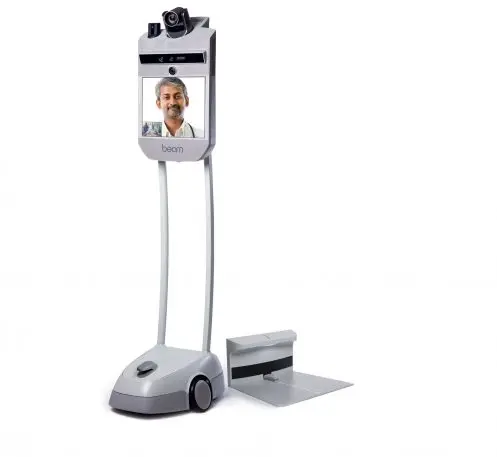You already have an idea of what the future of work looks like because you are likely already working with bots, artificial intelligence, and machine learning. They are increasingly being incorporated into everything from work stations to websites to cloud platforms.
But while the U.S. is leading the world in robotics investment, “There is clear evidence that points toward robotic automation in many cases being a complement for human labor, rather than a direct substitute,” says David Whitaker, managing economist at the Centre for Economic and Business Research.
As robots do more things in the office, which some experts say will free people to do more valuable, creative work, what will it be like to have them as our assistants and “office-mates?”
Form And Function
Many will be integrated into work stations and peripherals, as well as various cloud-based platforms says Marco Perry, a robotics expert, futurist, and founder of Brooklyn-based design and invention firm PENSA.
SAP research director Kai Goerlich says most of these “assistants” will likely be integrated into devices you already use with seamless interfaces. “We will have more algorithms, helping us do tedious office work. So, basically, tax analysis, image analysis, comparisons, statistics, etc.” He says that machines will likely evolve to rely more on voice recognition and less on keyboards. So, for example, give your device a voice command, such as scheduling a meeting or sending a document with a specific person or group, and the algorithm will exchange the necessary information with the target’s algorithm to get the task done.
That functionality is going to save time and improve the way we work, says futurist Nikolas Badminton. By the time you sit at your workstation, your tech assistant will likely have organized scheduling and tasks in anticipation of the day ahead. ‘You’re probably going to walk into an office and your system’s been churning over the last couple of hours considering what’s been going on in business, your role, your job, what you need to do that day, and probably offer up several ideas about the right direction of what to do,” he says.
In cases where a personal touch is still needed, robots can still be helpful. Just ask Jodi Goldstein, managing director of Harvard Innovation Lab (i-lab), a collaborative education and entrepreneurship initiative at Harvard University. Goldstein got a crash course in working with robots when Rony Abovitz, founder of augmented reality startup Magic Leap, was suddenly unable to deliver a keynote speech for her event, he offered to send his Beam. A beam is a robotic device with a monitor, speakers and camera. The device stands about 4 feet, 5 inches tall with a four-wheel base. It can be operated remotely, so it can move around the room and turn to face participants.
At first, Goldstein says she was concerned that it was going to be strange or awkward. However, as Abovitz operated the Beam remotely, his face on the screen, turning to address audience members and answer questions, she says that any apprehension she had went away.
“There was no diminished experience for the crowd,” she says. “It enabled us to have this phenomenal founder who, at the last minute, couldn’t be there. So when you think about the way telecommuting and telepresence, it can really change the interaction people have on a day-to-day basis in an office environment, I think it really unlocks a lot of potential value for office workers and management as well. You can have the right person, wherever they physically are, but you can have that person in the room when you need them to be.” This type of technology may give us a glimpse into how meetings will evolve and options for collaboration, she says.

New Skills Needed
While the concern about the jobs robots will take is well-documented, Paul R. Daugherty, Accenture’s chief technology and innovation officer, says that the proliferation of these technologies will create new roles, for which workers will need new skills. “We summarize those as trainers, explainers, and sustainers,” he says.
Trainers will include new jobs to train machines in artificial intelligence. (Think IBM’s Watson and its ability to answer questions and find answers through data analysis.) He says that a good example is people who are working on chatbots and virtual agents to help consumers interact with companies.
“There’s a need for personalities to train the artificial intelligence in the chatbots themselves, to embody the values of the company, the right personality,” he says. Explainers and sustainers are new jobs that involve explaining AI and how it’s working and maintaining or improving AI systems over time. This will create greater demand for people with technology skills, but will also create greater demand for soft skills, such as empathy trainers to help machines deal more effectively with people and who can analyze the needs of customers to ensure machines are effective in dealing with them.
“I would predict that five years out we’ll probably have a bigger shortage for those types of skills around, the softer skills around how can we shape the experience for people using machines and that will be a bigger skill deficit than the hard-core technology skills,” he says. Most of all, employees must stay open to learning new ways of working with technology.
As such technologies help more people, Daugherty says we’ll also need to learn to be comfortable interacting with them. He points to platforms like Autodesk’s Project Dreamcatcher, a generative design system that works with a designer’s or engineer’s project objectives and parameters to generate multiple design options. In addition, as more companies adopt virtual agents those whose jobs include interacting with those agents—finance departments working with banks’ increasing use of virtual agents, for example—will need to adapt to be comfortable interacting with these technologies, he says.
New Challenges For Managers And HR
Goldstein believes that robots and AI in the workplace will change human resources dramatically and create new challenges related to human and robot management. And while there will be a temptation to automate everything, the more sensitive or complex a situation, the more likely people will want to deal with an actual person, so it’s critical to consider the context in which you use robots, AI, and machine learning and determine if it’s really the best solution for the situation, Perry adds.
“If you completely automate that, people feel helpless,” he says. Frustration can also be a problem. For example, if you have a sensitive problem with your health insurance and can’t get anyone on the phone to help you navigate the challenge empathetically, you’re likely to feel a loss of control as well as feeling as if you’re not valued by the company, Perry says. Such a dynamic can alienate valued employees.
In addition, companies are going to need to take steps to protect workers’ privacy, Goldstein says. Just as smart home assistants like Google Home or Amazon Echo are “listening” all the time—monitoring ambient noise so they can be activated by “wake words,” office robots and machines will act similarly. This holds the potential for companies to inadvertently capture sensitive information about employees, she says. How that information will be used and protected are among the emerging issues companies must face.
As for job loss, Badminton isn’t convinced it’s going to be dire. History tells us that when innovation occurs, new jobs are created, he says.
And while these machines are designed to take away rote tasks to free workers to do more valuable, creative work, Perry worries there are consequences to being too reliant on machines to do our jobs.
“It makes us a little bit dumber,” he says, citing people who don’t know important phone numbers because they’re just stored in a device or who can’t find their way without GPS. “Not only does it take the control out of my hands, it takes the intelligence out of me because I don’t need to know that any longer. If the systems go down, you’re totally hosed. You can’t do anything about it,” he says.
Recognize your brand’s excellence by applying to this year’s Brands That Matter Awards before the early-rate deadline, May 3.
